Party animals
In parts of Australia, a dog’s life has become almost aspirational. But is it harmful to them?
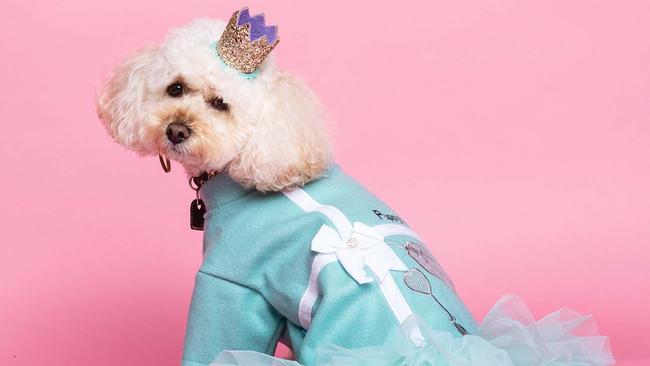
The birthday girl looks bored. Fifty of her best friends have arrived at her party, dressed as ring masters and clowns and even as a box of popcorn, in keeping with the event’s carnival theme. They have all brought carefully wrapped gifts, and as they file into a harbourside park on a sunny Saturday morning the exquisitely orchestrated scene that greets them would impress almost any child. There are games and prizes and overstuffed party bags, plus two carnival-themed tables spread with Instagram-worthy feasts: mini Ferris wheels laden with cupcakes, matching glass jars crammed with snacks and, as an impressive centrepiece, a two-tiered $150 birthday cake.
Party organiser Alina Michaels, wearing a black “Coco’s Mum” T-shirt, has spent the past eight months ensuring that her beloved five-year-old’s birthday celebration is a success. Apart from a fancy dress parade and a balloon twister distributing poodle-shaped balloons, Michaels has also secured close to $7000 worth of prizes and take-home gifts from a range of sponsors. This is in addition to the $2000 she has spent on the party.
It’s an enormous effort, yet Coco seems indifferent. As she stands beside her personalised carrot cake for the morning’s money shot, her frilled collar and skirt impeccably colour-coordinated with the bright decor, she is mostly impassive, even as the crowd serenades her with an enthusiastic round of Happy Birthday. Her friends, too, seem unmoved, remaining doggedly mute to the inquiries of the adults invariably cuddling them, whether it’s “Fendi, did you say hi to Coco?” or “Come with Mummy for a group shot?”

Because Coco is a dog. And like her canine friends at this park on Sydney’s lower north shore, she leads a very nice life. “These are our kids,” says one of the human attendees, Brendan Clay, who, with his wife Doris, has arrived with their adored french bulldog for one of four “doggy” events they will attend this weekend. Bailey, dressed today in a tutu and a party hat, leads a social life that would be the envy of many adults, a whirlwind of social gatherings involving countless photo opportunities (“the ‘mamarazzi’ goes nuts trying to get 15 dogs in one photo,” laughs Doris) and a cornucopia of gourmet treats.
Give a dog a bone? Not at these parties. From carob freckles to kangaroo bites and dried sardines, the spread for the pets can be just as lavish (and in Coco’s case even more extensive) than the food laid out for their owners. “I say that I make cakes for dogs, but I create cakes for humans,” says the man responsible for Coco’s stunning birthday cake, Jason Blachowski, a fixture at many of the guests’ pet parties. A visual feast of red and white striped dog-friendly icing emblazoned with an oversized “5”, the centrepiece, the cake — like everything at his boutique pet bakery, from doughnuts to lamingtons — intentionally looks like something you would find at an upmarket patisserie. “The secret to this business is that dogs will eat anything,” says Blachowski, a former head chef. “The decoration and garnish is for humans; it needs to look amazing.”
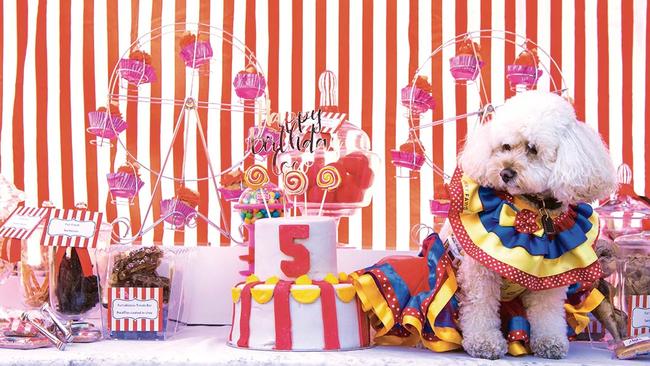
A dog’s life is not what it used to be. Once code for an unhappy existence, in parts of Australia it’s become almost aspirational thanks to our increasing love affair with all things canine. In 2019, if you have the means, your dog can enjoy a life that is decidedly middle class: beverages at the local cafe, three-course meals at dog-friendly eateries, dog parties. There are dog prams, designer dog beds costing hundreds of dollars, doggy day care centres and luxury canine resorts.
Australia has one of the world’s highest rates of pet ownership — there are almost as many domestic animals (about 24 million) as people. We spend more than $12.2 billion a year on them, up 42 per cent between 2013 and 2016. But of all our pets, we love dogs most. There are now more of them in Australia than there are children under 15. Found in two out of five homes, the nation’s five million canines were traditionally relegated to the often maligned doghouse. Increasingly, however, they are being treated not just as members of the family, but as if they were human.
“The amazing thing about dogs is that they are super flexible. They are like a gap-filler and as a species they have evolved to work out what a human needs,” says Professor Pauleen Bennett, who runs Australia’s first dedicated dog behaviour and cognition laboratory. “If we needed a hunting companion, there were dogs. And now we need somebody who can keep us feeling good about ourselves and provide social support and companionship — and what do you know, there’s dogs.”
As head of the department of psychology and counselling at La Trobe University, Bennett researches human-animal relationships. “At the moment,” she says, “people are looking at dogs as substitute children. But not even real children; it’s almost like the really dependent infant child.” Most popular are small breeds and, possibly unconsciously, those with human-like features.
“I don’t think the people who are buying dogs think about it that way,” says Dr Sarah Zito, senior scientific officer (companion animals) for RSPCA Australia. She has noted an increased penchant for pugs and other flat-faced breeds. “We just find round faces and bulging eyes appealing because they look like human babies.”
A 2014 report by the research group Euromonitor International identified three main types of owners keen to spend heavily on their pets. The smallest but perhaps most significant was the “extreme pet humaniser”, found, coincidentally, in some of the world’s leading fashion markets including Paris, Milan, Japan and the US. “This is the urban, usually female, pet owner who sees their pet as a baby or even a fashion statement, and is often willing to spend large amounts of money on their pet on products such as designer outfits and crystal-encrusted drinking bowls.”
Australia was not identified in that report, but it didn’t take long for the trend to migrate. By 2015, “fur baby” was being included in the Oxford and Macquarie dictionaries. By 2016, most of the top dog and cat names in Australia were human. And in July this year, Euromonitor International predicted that in the future “the relationship between [Australian] pet owners and their pets will only intensify, and the boundaries between what is traditionally human food and pet food will narrow as a result”.
It’s not just organic and Australian-made dog foods that are coveted. From a $4400 sterling silver Tiffany dog bowl to a mass-produced pirate costume at Kmart for less than $10, there are many ways to accessorise a canine today. “It probably doesn’t hurt most of the time, but it can be a bit ridiculous and it can be harmful,” says Bennett, citing some of the more extreme anthropomorphic examples. “I don’t think they have to parachute out of a plane to experience life.”
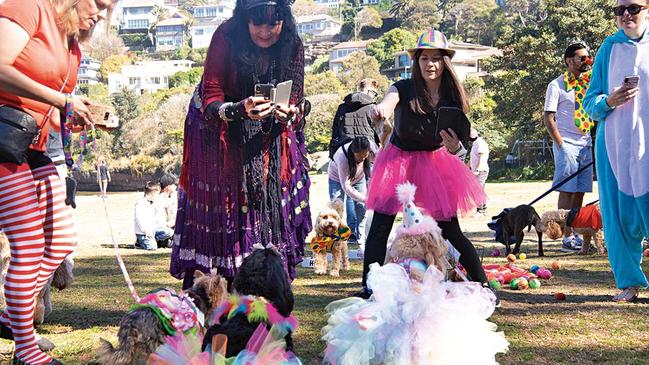
There is nothing wrong per se in dressing your poodle in a lobster costume or as a designer baby unless it causes discomfort, Bennett adds. “Providing dogs’ welfare is good, they are getting food and their basic needs are met, I don’t think they actually care if we treat them like babies. They are not humiliated by that… I don’t think they care whether their cardigan is pink or green.” The greater concern lies with human expectations. “People won’t tolerate dogs being dogs anymore,” she says. In recent years she has identified “a shift towards treating dogs [in a way] that is not doggy”. When it comes to, say, their pets being house-trained or their level of aggression, humans “think that dogs should know better”, she says. “Instead of saying no, they’re explaining to them why it’s no. And that’s not how dogs work.”
Partly that’s down to changes in the way in which we coexist with animals. “Even 50 or 60 years ago, everybody lived with a lot of animals. Now we have people who don’t live with animals in any capacity and they don’t understand them.” It’s also due to changes in disposable income. “People enjoy spending money on their pets and we have people today who can afford to do that.” Not everyone can afford such indulgences, though; nor do they necessarily desire them. “If you are struggling to survive you don’t treat your dog like a helpless infant,” says Bennett. “You don’t have the capacity to lavish that attention on it. We are talking about people who are basically well off.”
In some parts of Australia that desire is more pronounced. According to a 2016 report from Animal Medicines Australia, city households spend three times more than those in regional and rural areas on accessories such as toys and carriers, and 12 times more than households in regional areas on training and behaviour therapies.
Even within cities there can be a divide. In Sydney it depends on the area you’re in, says Blachowski, whose canine bakery also provides balloons and birthday cards (even though, he points out, dogs can’t read). “We sometimes do stalls around Sydney and you might get the odd male going, ‘What’s this rubbish? My dog is lucky to get a bone for his birthday.’” Blachowski suspects the love affair might be due to social media. “I’m just wondering if 10 years ago, if social media wasn’t around, would this be happening?”
Emma Hill set up an Instagram account for her weeks-old dachshund only days after acquiring him in 2016. Three years on, King Kingsley has 149,000 followers and his own website. He is also the “author” of three coffee table books that have sold more than 1000 copies. “People do recognise him on the street, and they’ll go, ‘Oh My God, King Kingsley!’” says Hill, 26, from the Gold Coast.
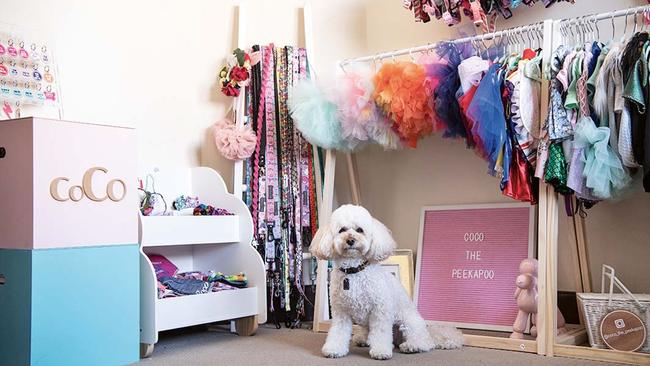
For a pampered canine in 2019, that sort of popularity has its benefits. Hill’s home is scattered with close to 20 of the many dog beds King Kingsley has been given, a booty that also includes a vacuum cleaner, dog lamps, leads and harnesses. But fame also has its price. “We’ve been stalked by a bunch of girls who really wanted to meet him,” says Hill. “And we have people who will come from overseas and ask us if they can meet Kingsley, which obviously I don’t feel comfortable doing.”
Still, compared to many other dogs with his social media status, King Kingsley leads a comparatively low-key life. He no longer has birthday parties. “He’s not into a big crowd of friends.” And he rarely wears anything more than a coat.
But plenty of others have been dropped into a world of designer labels, gluten-free diets and even nail polish. “A little bit of anthropomorphism is, I think, a good thing,” says Bennett. “I think they are a real sentient living creature, and we should recognise that. But in other respects they are dogs, and we should respect that. I love my dogs because they are dogs, not because they are baby humans.”
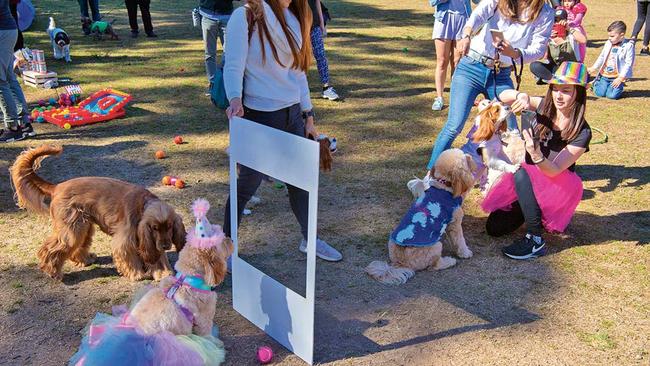
At Coco’s birthday party, almost everything is going to plan. The cake pops on gold “Coco” skewers have all gone from the humans’ table, and slices of birthday cake are being distributed to little dogs on gold paper plates. A red and white striped mini-marquee is groaning with gifts for the dog of the moment, among them a Chanel-like jumper (in honour of Coco’s namesake) and a “Chewnel” bag.
But despite the convivial atmosphere, the carnival games are mostly idle. A portable tunnel has been all but neglected, not least because few of the party dogs seem to even run around. Mostly they are leashed or held in an adult’s arms. (In a crowd of more than 60 people, there are only three children present.) For the first minutes of the party, no one even approaches the small stack of cans that are waiting to be knocked down with one of the little bean bags sitting beside them. Then one canine guest decides that the pile of cans is an ideal spot to make a statement.
The mortified owner screams. “I am very sorry. My dog pissed on everything,” she says as she tugs away her leashed french bulldog, a scene that will be repeated at least four more times as dog after dog pees on the cans, or on the adjacent basket of packaged chicken snacks, to the horror of their owners.
While the party games are largely ignored, there is plenty more to keep guests entertained. In a morning that is lively and joyous, easily the most popular activity is photography: either inside a cardboard Instagram frame celebrating Coco’s “barkday pawty” or to the loud sounds of humans clucking “lalalalala” as they attempt to snap their dogs staring at the camera.
Each of the 50 dogs invited to the party has his or her own Instagram account. They include Wally, a shih tzu/silky cross dressed as a ringmaster, Maisie, Harvey and Lola, two Teddys, two Oscars, and a couple of designer namesakes (Fendi and Dolce). All are impeccably groomed and most can be easily identified from other visitors at the popular dog park by the presence of clothes and the absence of mud or even dirt on their paws.
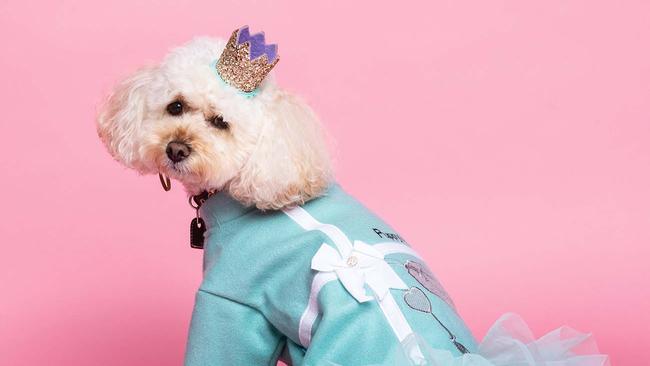
Birthday girl Coco, a poodle-Pekingese mix, has her own sizeable social media presence. Her 40,000 Instagram followers are treated to daily updates on her lavish lifestyle, featuring colourful parties with balloons and party bags, and doggy treats that look suspiciously like gourmet human goods. On quieter days she is photographed in one of her countless outfits or with her hair up-styled. “She loves seeing her friends, she loves dressing up,” says Michaels, 29, an office manager who lives with her husband Sarmen in Sydney’s north. Half of one room in their home is dedicated to what Michaels describes as Coco’s “furdrobe”: racks and shelves of multi-coloured tutus and coats, and a multitude of collars and leashes, including a couple of designer styles that cost close to $1000 each.
Michaels readily concedes there is no limit to what she would do or how much she would spend on her beloved dog. “We want to have kids eventually. But at this stage I am enjoying my time with Coco.” Her dedication is impressive. Although she works full time, she spends four hours a day maintaining Coco’s social media presence. That’s in addition to the months spent fine-tuning today’s party, which in turn brings together the enormous social circle she has developed through Coco.
“For me it’s seeing her happy. It’s the joy; it gives you joy seeing dogs happy, bringing everyone together,” says Michaels when asked why she stages such lavish parties for a dog. (Coco’s fourth birthday was celebrated with a pink-themed bash, with lots of colourful treats and complimentary bow ties for guests.) “People always ask why I don’t do dog birthdays as a job. I love Coco but she is such a picky girl, she doesn’t eat half the stuff that’s there for her party. It’s for the other dogs.”
After the cake cutting and fancy dress parade, Michaels spends the remainder of the morning distributing gifts. Every dog takes home a $30 bottle of perfume and a party bag that includes snacks, a key ring and a spray to eliminate urine odours. While Michaels is busy attending to her many guests, Coco remains securely in the arms of another dog’s “mum”.
“She’s had a long day,” Michaels explains later when asked why Coco has had little if any time on the ground for the duration of the party. “We started very early this morning. She was going lap to lap, people taking photos.” When it’s all over, Michaels is exhilarated and understandably exhausted. So does she think Coco has enjoyed the party with all her canine friends? “Oh yeah, they love seeing each other,” she says. Then smiles. And pauses. “You probably think we’re crazy.”


To join the conversation, please log in. Don't have an account? Register
Join the conversation, you are commenting as Logout